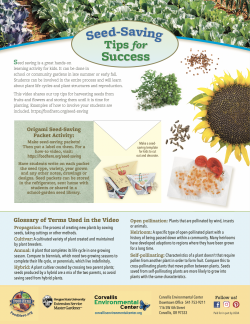Seed-Saving Tips for Success
Seed saving is a great hands-on learning activity for kids. It can be done in school or community gardens in late summer or early fall. Students can be involved in the entire process and will learn about plant life cycles and plant structures and reproduction.
The video series shares our top tips for harvesting seeds from fruits and flowers and storing them until it is time for planting. Examples of how to involve your students are included.
- Seed-Saving Video 1: Terms
- Seed-Saving Video 2: Introduction and Tips for Success
- Seed-Saving Video 3: Harvesting and Cleaning Seeds
- Seed-Saving Video 4: Seed Storage
Glossary of Terms Used in the Videos
- Propagation: The process of creating new plants by sowing seeds, taking cuttings or other methods.
- Cultivar: A cultivated variety of plant created and maintained by plant breeders.
- Annual: A plant that completes its life cycle in one growing season. Compare to biennials, which need two growing seasons to complete their life cycle, or perennials, which live indefinitely.
- Hybrid: A plant cultivar created by crossing two parent plants; seeds produced by a hybrid are a mix of the two parents, so avoid saving seed from hybrid plants.
- Open pollination: Plants that are pollinated by wind, insects or animals.
- Heirloom: A specific type of open-pollinated plant with a history of being passed down within a community. Many heirlooms have developed adaptions to regions where they have been grown for a long time.
- Self-pollinating: Characteristics of a plant doesn’t that require pollen from another plant in order to form fruit. Compare this to cross-pollinating plants that move pollen between plants. Seeds saved from self-pollinating plants are more likely to grow into plants with the same characteristics.
Origami Seed-Saving Packet Activity
- Make a seed-saving template for kids to cut out and decorate.
- Make seed-saving packets and then put a label on them.
- Have students write on each packet the seed type, variety, year grown and any other notes, drawings or designs. Seed packets can be stored in the refrigerator, sent home with students or shared in a school-garden seed library.
- Watch this how-to video for origami package directions.



